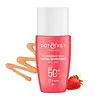Bioderma Photoderm Creme Light Tinted SPF 50+ Versus Dot & Key Skincare Strawberry Dew Tinted Sunscreen SPF 50+
What's inside
What's inside
 Key Ingredients
Key Ingredients

 Benefits
Benefits

 Concerns
Concerns

 Ingredients Side-by-side
Ingredients Side-by-side

Water
Skin ConditioningDiethylamino Hydroxybenzoyl Hexyl Benzoate
UV FilterHomosalate
Skin ConditioningDiisopropyl Sebacate
EmollientBis-Ethylhexyloxyphenol Methoxyphenyl Triazine
Skin ConditioningDibutyl Adipate
EmollientPropanediol
SolventEthylhexyl Salicylate
UV AbsorberEthylhexyl Triazone
UV AbsorberSilica
AbrasiveGlycerin
HumectantCI 77891
Cosmetic ColorantPropylene Glycol
HumectantSucrose Stearate
EmollientGlyceryl Stearate
EmollientPEG-100 Stearate
CI 77492
Cosmetic ColorantPentylene Glycol
Skin Conditioning1,2-Hexanediol
Skin ConditioningSodium Citrate
BufferingXanthan Gum
EmulsifyingCI 77491
Cosmetic ColorantCaprylyl Glycol
EmollientPolyacrylate Crosspolymer-6
Emulsion StabilisingCitric Acid
BufferingCI 77499
Cosmetic ColorantEctoin
Skin ConditioningMannitol
HumectantXylitol
HumectantRhamnose
HumectantFructooligosaccharides
HumectantCaprylic/Capric Triglyceride
MaskingLaminaria Ochroleuca Extract
Skin ConditioningWater, Diethylamino Hydroxybenzoyl Hexyl Benzoate, Homosalate, Diisopropyl Sebacate, Bis-Ethylhexyloxyphenol Methoxyphenyl Triazine, Dibutyl Adipate, Propanediol, Ethylhexyl Salicylate, Ethylhexyl Triazone, Silica, Glycerin, CI 77891, Propylene Glycol, Sucrose Stearate, Glyceryl Stearate, PEG-100 Stearate, CI 77492, Pentylene Glycol, 1,2-Hexanediol, Sodium Citrate, Xanthan Gum, CI 77491, Caprylyl Glycol, Polyacrylate Crosspolymer-6, Citric Acid, CI 77499, Ectoin, Mannitol, Xylitol, Rhamnose, Fructooligosaccharides, Caprylic/Capric Triglyceride, Laminaria Ochroleuca Extract
Water
Skin ConditioningEthylhexyl Methoxycinnamate
UV AbsorberButyl Methoxydibenzoylmethane
UV AbsorberBenzophenone-3
UV AbsorberPhospholipids
Skin ConditioningButylene Glycol
HumectantIsododecane
EmollientGlycerin
HumectantPhenyl Trimethicone
Skin ConditioningPropanediol
SolventTitanium Dioxide
Cosmetic ColorantTriethoxycaprylylsilane
Polyhydroxystearic Acid
EmulsifyingGlyceryl Citrate/Lactate/Linoleate/Oleate
EmulsifyingCyclopentasiloxane
EmollientDimethicone Crosspolymer
Emulsion StabilisingCaprylic/Capric Triglyceride
MaskingDicaprylyl Carbonate
EmollientTapioca Starch
Polymethylsilsesquioxane
Fragaria Vesca Fruit
AstringentFragaria Ananassa Fruit Extract
Skin ConditioningSodium Hyaluronate
HumectantNiacinamide
SmoothingPanthenol
Skin ConditioningTocopheryl Acetate
AntioxidantPolyglyceryl-3 Polyricinoleate
EmulsifyingXanthan Gum
EmulsifyingPolyacrylate Crosspolymer-6
Emulsion StabilisingPolyacrylate-13
Polyisobutene
Polysorbate 20
EmulsifyingSodium Gluconate
Skin ConditioningPhenoxyethanol
PreservativeEthylhexylglycerin
Skin ConditioningDisodium EDTA
CI 77491
Cosmetic ColorantCI 77492
Cosmetic ColorantWater, Ethylhexyl Methoxycinnamate, Butyl Methoxydibenzoylmethane, Benzophenone-3, Phospholipids, Butylene Glycol, Isododecane, Glycerin, Phenyl Trimethicone, Propanediol, Titanium Dioxide, Triethoxycaprylylsilane, Polyhydroxystearic Acid, Glyceryl Citrate/Lactate/Linoleate/Oleate, Cyclopentasiloxane, Dimethicone Crosspolymer, Caprylic/Capric Triglyceride, Dicaprylyl Carbonate, Tapioca Starch, Polymethylsilsesquioxane, Fragaria Vesca Fruit, Fragaria Ananassa Fruit Extract, Sodium Hyaluronate, Niacinamide, Panthenol, Tocopheryl Acetate, Polyglyceryl-3 Polyricinoleate, Xanthan Gum, Polyacrylate Crosspolymer-6, Polyacrylate-13, Polyisobutene, Polysorbate 20, Sodium Gluconate, Phenoxyethanol, Ethylhexylglycerin, Disodium EDTA, CI 77491, CI 77492
 Reviews
Reviews

Ingredients Explained
These ingredients are found in both products.
Ingredients higher up in an ingredient list are typically present in a larger amount.
This ingredient is an emollient, solvent, and texture enhancer. It is considered a skin-softener by helping the skin prevent moisture loss.
It helps thicken a product's formula and makes it easier to spread by dissolving clumping compounds.
Caprylic Triglyceride is made by combining glycerin with coconut oil, forming a clear liquid.
While there is an assumption Caprylic Triglyceride can clog pores due to it being derived from coconut oil, there is no research supporting this.
Learn more about Caprylic/Capric TriglycerideCi 77491 is also hydrated iron III oxide. It's sole purpose is to give a red/pink hue to products.
Iron III oxides are classified as inorganic chemicals for coloring.
Synthetically created Ci 77491 is considered safer than those naturally found. This is because the synthetically created version may contain less impurities. Iron oxides are generally non-toxic and non-allergenic.
Learn more about CI 77491Ci 77492 is also hydrated iron III oxide. It's sole purpose is to give a yellow hue to products.
Iron III oxides are classified as inorganic chemicals for coloring.
Synthetically created Ci 77492 is considered safer than those naturally found. This is because the synthetically created version may contain less impurities. Iron oxides are generally non-toxic and non-allergenic.
Learn more about CI 77492Glycerin is already naturally found in your skin. It helps moisturize and protect your skin.
A study from 2016 found glycerin to be more effective as a humectant than AHAs and hyaluronic acid.
As a humectant, it helps the skin stay hydrated by pulling moisture to your skin. The low molecular weight of glycerin allows it to pull moisture into the deeper layers of your skin.
Hydrated skin improves your skin barrier; Your skin barrier helps protect against irritants and bacteria.
Glycerin has also been found to have antimicrobial and antiviral properties. Due to these properties, glycerin is often used in wound and burn treatments.
In cosmetics, glycerin is usually derived from plants such as soybean or palm. However, it can also be sourced from animals, such as tallow or animal fat.
This ingredient is organic, colorless, odorless, and non-toxic.
Glycerin is the name for this ingredient in American English. British English uses Glycerol/Glycerine.
Learn more about GlycerinPolyacrylate Crosspolymer-6 is a texture enhancer and pH adjuster.
It is be used to thicken water-based products and create a gel-texture with a velvet feel.
One manufacturer claims this ingredient to have a pH range of 2-8 and to be biodegradable.
Learn more about Polyacrylate Crosspolymer-6Propanediol is an all-star ingredient. It softens, hydrates, and smooths the skin.
It’s often used to:
Propanediol is not likely to cause sensitivity and considered safe to use. It is derived from corn or petroleum with a clear color and no scent.
Learn more about PropanediolWater. It's the most common cosmetic ingredient of all. You'll usually see it at the top of ingredient lists, meaning that it makes up the largest part of the product.
So why is it so popular? Water most often acts as a solvent - this means that it helps dissolve other ingredients into the formulation.
You'll also recognize water as that liquid we all need to stay alive. If you see this, drink a glass of water. Stay hydrated!
Learn more about WaterXanthan gum is used as a stabilizer and thickener within cosmetic products. It helps give products a sticky, thick feeling - preventing them from being too runny.
On the technical side of things, xanthan gum is a polysaccharide - a combination consisting of multiple sugar molecules bonded together.
Xanthan gum is a pretty common and great ingredient. It is a natural, non-toxic, non-irritating ingredient that is also commonly used in food products.
Learn more about Xanthan Gum